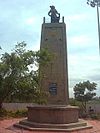Veerapandiya Kattabomman
| Kattabomman Naiyakar | |
|---|---|
| Palaiyakkarar of Tenkasi | |
 Veerapandiya Kattabomman on a 1999 stamp | |
| Reign | Ended 16 October 1799 |
| Successor | British Rule |
| Born | 3 January 1760 Panchalankurichi, India |
| Died | 16 October 1799 (aged 39) Kayathar, India |
| Spouse | Jakkammal[citation needed] |
| Father | Jagaveera Kattabomman[citation needed] |
| Mother | Arumugathammal[citation needed] |
Veerapandiya Kattabomman[1] was an 18th-century Tamil Palayakarrar and chieftain in Tamil Nadu, India. He refused to accept the sovereignty of the British East India Company and waged a war against them. He was captured by the British with the help of the ruler of the kingdom of Pudukottai, Vijaya Raghunatha Tondaiman, and at the age of 39 he was hanged at Kayathar on 16 October 1799.[2]
He was a Vatuka (northerner), a loose term for a group of Telugu-speaking castes which includes families who claim to have moved south to settle in the arid Tirunelveli region after the collapse of the Nayaka-controlled Vijayanagara Empire in 1565. They had previously had some prominence in the imperial court and may have been adept at farming in dry conditions, although it is also possible that they had no choice but to settle where they did because the other significant community of Tirunelveli – the Maravars – had already occupied the more favourable areas. Kattabomman was a member of the , with the other two Vadugan communities being the Kammavars and the Reddies.[3]
Legacy[]

The historian Susan Bayly says that Kattabomman is considered a Robin Hood-like figure in local folklore and is the subject of several traditional narrative ballads in the kummi verse form. The site of his execution at Kayathar has become a "powerful local shrine" and at one time sheep were sacrificed there.[4] The Government of Tamil Nadu maintains a memorial at Kayathar and the remnants of the old fort at Panchalankurichi is protected by the Archaeological Survey of India.[5][6] In 2006, the Tirunelveli district administration organised a festival at Panchalankurichi on his birth anniversary.[7]
The Tamil-language film Veerapandiya Kattabomman, starring Sivaji Ganesan, is based on his life.[8]
To commemorate the bicentenary of Kattabomman’s hanging, the Government of India released a postal stamp in his honour on 16 October 1999.[9] The Indian Navy communications centre at Vijayanarayanam is named INS Kattabomman.[10]
Controversies[]
Tamil poet Kannadasan wrote a script about Kattabomman which was adapted into Sivagangai Seemai. According to him Maruthu Pandiyars were the real freedom fighters, not Kattabomman. Kannadasan's assertion was supported by writer Tamilvanan, who criticised Kattabomman's glorification.[11]
See also[]
- Puli Thevar
- Dheeran Chinnamalai
- Maruthu Pandiyar
- Veeran Sundaralingam
- Oomaithurai, Veerapandiya Kattabomman's younger brother
- Rani Velu Nachiar
Further reading[]
- Sivagnanam, M. P. (1940). Veerapandiya Kattabomman.
- Karunakarapandian, K. (2011). "A Political History of Ettayapuram of Thirunelvelli District, Tamil Nadu". In Ganeshram, S.; Bhavani, C. (eds.). History of People and Their Environs: Essays in Honour of Prof. B.S. Chandrababu. Bharathi Puthakalayam. ISBN 978-9-38032-591-0.
- Mukund, Kanakalatha (2005). The View from Below: Indigenous Society, Temples, and the Early Colonial State in Tamilnadu, 1700–1835. Orient Blackswan. ISBN 978-8-12502-800-0.
References[]
- ^ Narwekar, Sanjit (1994). Directory of Indian film-makers and films. ISBN 9780948911408.; "Glimpse into history". The Hindu. 20 July 2011. Retrieved 5 March 2018.; "Metro Plus Vijayawada". The Hindu. 22 January 2005. Retrieved 5 March 2018.
- ^ Yang, Anand A. (November 2007). "Bandits and Kings: Moral Authority and Resistance in Early Colonial India". The Journal of Asian Studies. 66 (4): 881–896. doi:10.1017/S0021911807001234. JSTOR 20203235.
- ^ Dirks, Nicholas B. (1987). The Hollow Crown: Ethnohistory of an Indian Kingdom. Cambridge University Press. pp. 60–70, 174. ISBN 0-521-32604-4.
- ^ Bayly, Susan (1989). Saints, Goddesses and Kings: Muslims and Christians in South Indian society, 1700–1900. Cambridge University Press. p. 207. ISBN 978-0-521-37201-5.
- ^ "Tourism in Thoothukudi district". Government of Tamil Nadu.
- ^ "Jayalalithaa inaugurates memorial for Veerapandia Kattaboman". The Hindu. 19 June 2015.
- ^ "Kattabomman festival celebrated". The Hindu. 14 May 2006. Retrieved 4 March 2018.
- ^ Guy, Randor (9 May 2015). "Veera Pandya Kattabomman 1959". The Hindu. Retrieved 20 February 2017.
- ^ "Tamilnadu postal circle — stamps". Tamil Nadu post.
- ^ "INS Kattabomman". Global security.
- ^ C, Sowmya Dechamma C.; Dechamma, Sowmya; Prakash, Elavarthi Sathya (2010). Cinemas of South India: Culture, Resistance, Ideology. Oxford University Press. ISBN 9780198067955.
- 1761 births
- 1799 deaths
- Indian revolutionaries
- People executed by British India by hanging
- Executed Indian people
- People from Tirunelveli district
- Polygar Wars